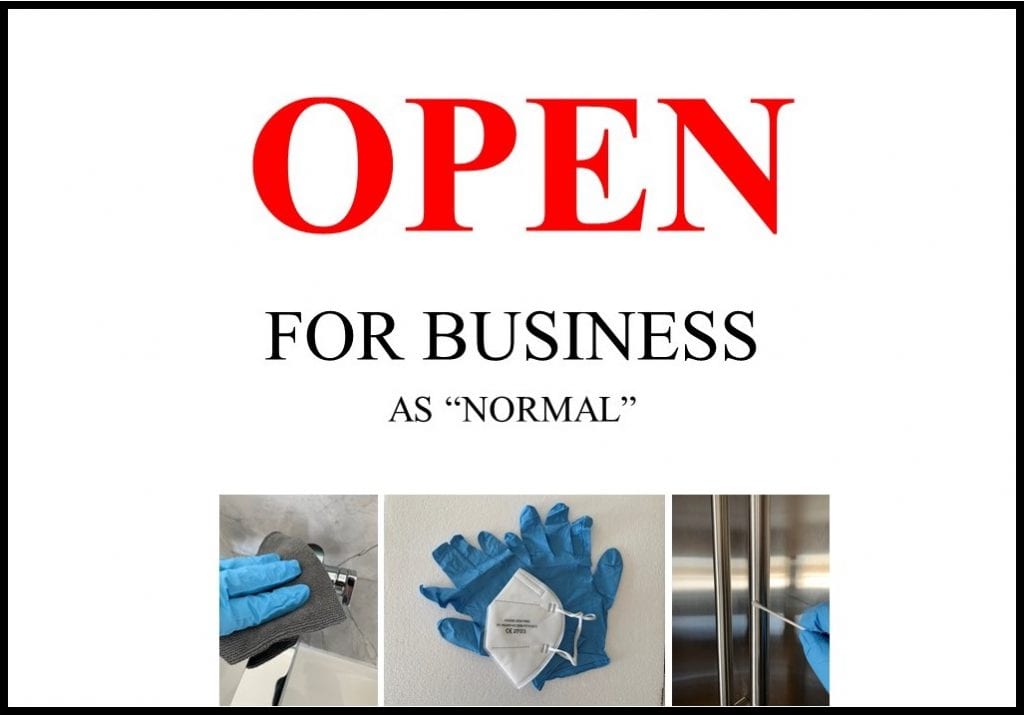
COVID-19: Expert Tips for Reopening Your Business Now
In order to successfully reopen your business, you may need to demonstrate that you are addressing COVID-19 health issues in a scientific and pragmatic way. In this article I will outline procedures that can be put in place to help protect employees and customers, address the need for cleaning and document whether cleaning is performed adequately.
Before I get into the three steps to take for reopening, let’s review the current understanding about how the virus is transmitted.
According to the CDC, the SARS-CoV-2 virus is most likely spread by aerosol transmission. Aerosols are water droplets, mucus proteins and other biological materials that are less than five micrometers (<5 µm) in size (a µm is 1/1,000 of a millimeter). The virus particle itself is only about 0.1 µm in size but is almost always bonded to an aerosol.
Aerosols are generated through normal breathing, talking, sneezing, coughing or by simply flushing a toilet. These particles can be airborne, can be deposited on surfaces and can be re-aerosolized if disturbed or as moisture evaporates. If aerosols contain the virus in sufficient quantity, a susceptible person could inhale them and become infected.
To reopen successfully we need to take appropriate protective measures to overcome this deadly pandemic and make workplaces as safe as possible. The key to successful reopening is to create a plan that includes procedures to:
- Reduce the chance of virus transmission and limit potential exposure
- Implement disinfection and sanitization measures
- Conduct testing to confirm COVID-19 protective measures are effective
1. Reduce the chance of virus transmission and limit potential exposure
Since people become infected with the virus by inhaling aerosols, the initial step is to reduce the generation and spread of aerosols. In this case the (most current) CDC recommendations are:
- Wear a mask
- Maintain 6 ft social distance
- Erect dividers and partitions
- Encourage vaccination when eligible
- Encourage employees and visitors to stay at home if they are experiencing any of the following symptoms: Fever, chills, a new cough, shortness of breath, sudden loss of taste or smell, diarrhea
- Follow isolation or quarantine guidelines if you are sick or have been in close contact with someone who has symptoms or tested positive for COVID-19.
2. COVID-19 disinfection and sanitization procedures
CDC testing has shown viruses can live on surfaces for days and be transferred by touch or by re-aerosolization as moisture evaporates. In order to mitigate the spread of virus from surfaces, it is important to follow rigorous disinfection and sanitization procedures. Special focus should include disinfection of common touch surfaces such as elevator buttons, door handles, railings, keyboards, TV remotes, light switches, toilets, faucets and sinks, counter tops, touch screens, etc. These surfaces should be sanitized using an EPA approved disinfectant proven to kill the SARS-CoV-2 virus.
Since aerosols are continuously moving and being deposited and re-deposited on surfaces, it is important to perform regular sanitization. Be sure to include disinfection of plexiglass dividers and partitions in your cleaning regimen. Reference the CDC guidance for cleaning and disinfecting for more information about these procedures.
3. COVID-19 testing to confirm protective measures are effective
Companies and health authorities are seeking solutions to monitor for the presence of SARS-CoV-2 in their environments to facilitate immediate sanitation and other measures to protect the health and safety of employees and their environment. Specific COVID-19 sampling and RT-PCR testing procedures provide a unique opportunity to assess the need for cleaning and to document whether the cleaning has been performed adequately. Testing is also relevant for suppliers to document that no infection has been left after delivery, repair and maintenance of machines and equipment. It will enable organizations in diverse industries to test, determine, monitor and strengthen the effectiveness of implemented sanitation measures.
Accurate sampling and testing for the presence of virus particles is crucial to assess the risk of potential exposure and transmission. Therefore, we need to test commonly touched surfaces, the air we are breathing and the PPE we are wearing.
Testing of Common Touch Surfaces
Thorough cleaning is important to avoid further spread of COVID-19. Confirmation of sanitization is accomplished by RT-PCR test for the detection of Coronaviruses and SARS-CoV-2 on surface swabs. This test provides the opportunity to determine the presence of the COVID-19 virus on solid surfaces. Documentation of negative virus presence is key to developing employee and customer confidence.
HVAC Sampling
Swab testing of return air plenums and filters is conducted to determine if an HVAC system is circulating the SARS-CoV-2 virus. Indoor air can be re-conditioned and circulated multiple times. This type of testing is key to assessing the need for more extensive disinfection.
Indoor Air Monitoring
Air testing has relevance for a wide range of applications. This test provides a unique opportunity to evaluate indoor spaces for the presence of the SARS-COV-2 virus in the air. The potential use of the test spans from public buildings, hospitals, transportation, offices, classrooms and homes to manufacturing sites, restaurants, hotels and other indoor environments. For buildings that are used by the same group of people the test may provide relevant information to detect or prevent infections or outbreaks. In other settings with changing occupancy the overall air quality and general risk of potential exposure can be assessed.
High traffic or large gathering areas such as cafeterias, auditoriums and gymnasiums may benefit from aerosol testing for COVID-19 to re-assure customers and audiences. Aerosol testing does not address transmission caused by direct contact or when in close proximity to an infected individual. It does, however, enable us to address aerosol transmission and air quality as it relates to SARS-CoV-2.
Bulk Face Mask Testing
Face masks accumulate nasal secretions. Virus has been detected on the inner surface of disposable non-medical masks worn by infected individuals. Non-medical masks worn by individuals can be tested for the presence of SARS-CoV-2. Bulk testing of disposable face masks following a work period may eliminate the need for invasive nasal swab testing of individuals. Up to five (5) face masks can be composited and analyzed. If a composite group of masks test negative, then individual tests can be avoided. While this type of test is no replacement for clinical tests, the detection of COVID-19 virus on worn masks represents a non-invasive, additional tool for SARS-CoV-2 environmental testing.
This type of test can be particularly useful to monitor the virus presence in work groups, living groups and sports teams. Results can be available in as few as 24 hours.
Wastewater Testing
Infected people have been shown to shed the virus when they use the restroom. Wastewater testing is used to determine if building occupants are shedding the COVID-19 virus. This type of testing is effective for buildings with up to 1,000 occupants. Automated composite 24-hr samplers are used to collect weekly or twice weekly samples. By utilizing quick turnaround services, it is possible to ascertain virus detection three to four days in advance of symptoms. Positive results indicate the need for more testing to identify current symptomatic or asymptomatic cases among occupants and take appropriate action.
Key Takeaways
We can reopen successfully. We have to take appropriate protective measures including:
- Establish and document procedures to reduce the number of aerosols that are spread by potentially affected people.
- Develop a sanitization process and use EPA certified products proven to kill the virus on contact.
- Conduct RT-PCR testing to verify your disinfection process and give employees and customers confidence in the protective measures you have put in place for your business.

